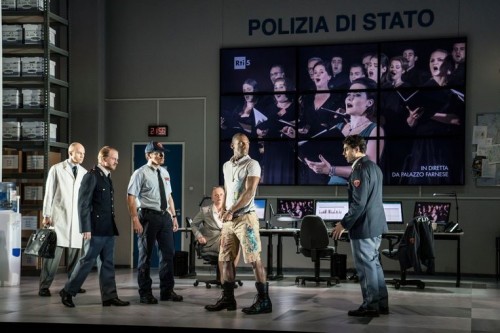 Netherlands Puccini, Tosca: Soloists, Consensus Vocalis, Het Orkest van het Oosten / David Parry (conductor), Nederlandse Reisopera, Stadstheater Arnhem, 8.11.2018. (SS)
Netherlands Puccini, Tosca: Soloists, Consensus Vocalis, Het Orkest van het Oosten / David Parry (conductor), Nederlandse Reisopera, Stadstheater Arnhem, 8.11.2018. (SS)

Production:
Director – Harry Fehr
Set and costume design – Yannis Thavoris
Lighting – John Bishop
Cast:
Floria Tosca – Kari Postma
Mario Cavaradossi – Noah Stewart
Baron Scarpia – Phillip Rhodes
Sacristan – Oleksandr Pushniak
Cesare Angelotti – Roman Ialcic
Spoletta – Michael J. Scott
Sciarrone – Simon Wilding
Jailer – Alexander de Jong
Shepherd boy – Bernadeta Astari
Staging Tosca, given its specificities and how strongly ritualized these have become, is a job to be done either by traditionalists (let them at least have Tosca, if nothing else) or radical thinking directors in the mould of Calixto Bieito or Peter Konwitschny. There’s no use in triangulation; in updating the Roman setting but otherwise rehearsing the same motions as Zeffirelli and Schenk. Yet there is a surplus of productions that do precisely that, of which this new staging for the Dutch Touring Opera is another example.
As for that ‘update’: this tends to be fascism, with Mussolini’s Italy as a go-to setting. Whenever I read about a Mussolini-era Tosca – is it such a coincidence that this phenomenon is predominantly driven by Anglophone directors? – the fascism seems only ever to be present as superficial window-dressing. It’s frustrating and unsatisfying to watch a production that uses the fascist aesthetic, of all things, as something eye-catching and decorative – while obstinately declining to relate 20th-century horrors to the opera’s substance in any meaningful way.
Harry Fehr’s new production for the Dutch Touring Opera is not another Mussolini Tosca but does relocate the action to a menacingly authoritarian present: essentially the same conceit. The entire opera is set in the police headquarters of a modern police state. The letters and logo of the ‘Polizia di Stato’ bear down on the set from above a bank of surveillance screens. To the left, shelves filled with evidence boxes rise to the flies. A cubicle with blinds is placed upstage right, and in front of that Scarpia’s desk. Downstage is a large clear space where most of the action takes place.
Before the opera begins, officials exchange words, ordering the surveillance to commence. The Sacristan and Cavaradossi then burst through the main door to the room, which at that moment becomes Sant’Andrea della Valle. The cubicle becomes the Attavanti chapel, the police officers’ water cooler becomes the church’s holy water font, and similar substitutions continue through all the three acts. We don’t even need to figure out what is being substituted for what, as the ‘real’ settings are shown on the surveillance screens. Indeed, the entire action of the opera is mirrored there, with avatars for all the characters simulating all their blocking and gestures in near real-time.
But what plays out amid this seemingly topical dystopia is cravenly identical to any ultra-traditional Tosca. Even the candlestick fetishists are indulged, when Tosca returns to Scarpia’s body and switches on his desk lamp in the usual ceremonial manner, although she does deliver ‘Vissi d’arte’ sitting rather than from the floor. One ‘twist’, thanks to the screens, comes when we are shown a livestream of Tosca performing her cantata – I think this was intended, embarrassingly, to be a coup de théâtre. The rest of the stage action offers nothing you haven’t already seen in a hundred other productions, and by virtue of the CGI movements on the screens you watch it all in duplicate. In order for a work this familiar to unsettle and put you on edge – in the program, Fehr does create this expectation by likening it to a ‘thriller’ – surely the events on stage have to be more unpredictable and, at the very least, far less timid?
The problems of the staging weren’t helped by conductor David Parry’s measured, almost plodding tempi. The score calls for more turbulence than was on offer here and the snarl of the music associated with Scarpia didn’t come through either. Still, the smoothness of the Orkest van het Oosten’s playing, even if too genteel for Tosca, did sound elegantly honed, especially in the winds. An interesting transparency of texture throughout, leaning towards chamber music, was otherwise the most striking aspect of the conducting.
I liked Kari Postma’s Tosca very much. There’s a lush, wholesome glow to her timbre that feels almost nourishing to listen to and she has the technique to handle the role effortlessly – two qualities which more than offset the strident edge she lacks to make Tosca an imperious diva. It’s hardly necessary to see every Tosca chew the scenery, and while Postma’s pragmatic Tosca was harder to believe as a murderess, her calmer take on the character generally succeeded on its own terms.
Noah Stewart’s ebullient painter was also easy to like. Stewart is still a young tenor, vocally and physically full of beans, but at this stage slightly underpowered for Cavaradossi. The voice does, however, show signs of a brightly heroic ring that could make him a singer to watch out for. Phillip Rhodes’s Scarpia didn’t dominate the stage or even loom much over the Te Deum, but instead gave a more understated and natural display of toxic masculinity, with a cold core of steel running through his singing. Of the smaller roles, Roman Ialcic was in best voice as a panic-stricken Angelotti.
Sebastian Smallshaw
